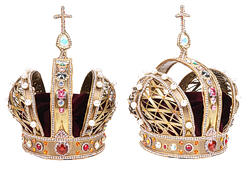Once upon a time, the stone of amethyst enjoyed the same status as the diamonds today. It once used to grace the outfits of the kings and the clergies and was only known to revolve among elites and royalties.
Among all the stones that the human race has come to discover, and would probably continue to discover, Amethyst enjoys some of the richest historical tales.
This is still a stone of the royals; its vivid purple color reflects this. Interestingly, its status as a privileged gemstone wasn’t just recognized by the crowned heads of one nation, but also by many others. This is proven by the fact that this stone is a part of royal collections all over the world.
The Earliest Use of Amethyst by the Greeks
The earliest use of this mineral dates back to the days of ancient Greece. In fact, the stone got its famous name from the Greek word, amethystos, meaning literally, not drunk.
It was accredited as the stone that protects its owner from the state of drunkenness.
A Greek legend even says that this stone was the creation of the Greek God of Wine, Dionysus. According to the legend, a mere mortal insulted Dionysus, and in his fit of rage, Dionysus vowed to unleash his revenge on the next person who would cross his path. As it so happens, the first person he saw right after his vow, was a beautiful young maiden who was on her way to pay homage to Artemis, the goddess of childbirth and virginity. True to his promise, Dionysus unleashed furious tigers upon the young maiden. As they leaped to attack her, Artemis stepped in to save the maiden by turning her into a statue of white quartz.
One legend says that Dionysus poured a cup of grape wine out of remorse for his actions that gave amethyst its rich purple color and its anti-drinking effects.
Another legend says that in his intoxicated condition, Dionysus showered his wrath on a young virgin named Amethyst. The maiden cried out to goddess Diana for help. Diana turned the maiden into a white amethyst.
Out of remorse, Dionysus cried and his purple tears fell on the white quartz.
Whatever the myth, the Greeks firmly believed that the amethyst was a stone of sobriety and would prevent a person from drinking excessively.
Amethyst in the Lives of the Egyptians
Egyptian folklore wasn’t too far off from Greek mythology. The ancient Egyptians used amethyst as a sign for the zodiac of the goat. The goat was symbolic for animosity with vine and vineyard and hence, the antidote for alcohol.
Amethyst wasn’t as prevalent in the Egyptian culture as it was in the Greek and Roman culture. However, it was acknowledged and valued in ancient Egypt as well. Its use in Egyptian culture dates back to 3000 BC. Egyptians used to wear amethyst to protect themselves from feelings of guilt and fear.
The royal stone was also worn by the ancient Egyptians to ward off the effects of witchcraft. It was found in many of the Egyptian tombs, including the tombs of their long dead ancient kings.
A beaded amethyst bracelet was discovered in the tomb of Djer, the second pharaoh of Egypt’s 1st dynasty. A bracelet inset with a large amethyst scarab was also found in the tomb of Tutankhamen, the boy-king of ancient Egypt.
The beloved Queen Mereret’s tomb was also found housing amethyst heart scarabs as well as an anklet with beads of gold and amethyst adorning it.
This shows that even the kings and queens of Egypt were enamored with the beauty of the amethyst.
The Royal Stone in Italy
Italy isn’t behind on their love for the amethyst either. In fact, the Iron Crown of Lombardy is one of the oldest surviving crowns that contains amethyst jewels.
A crown that old and precious is certain to come with a fable. Legend has it that the bands of iron in the crown are from the crucifixion nails of Christ. This legendary crown dates back to the middle ages and is made of 22 gemstones. To be more exact, it contains four violet amethysts, seven red garnets, four gems of glass, and seven blue sapphires.
Italians weren’t the only ones who owned a gem so valuable and prized. The regalia of France, Norway, and Georgia were also rich in amethyst jewels.
However, there was a kingdom that surpassed every other. When it came to owning profligate amethyst jewels, the British regalia took the crown–literally!
Amethyst in the British Crown Jewels

The British crown also owns five famous scepters in its collection. Every British monarch held that one of these royal scepters in their right hand during their coronation. And then there’s the Orb. It is cut out of a large amethyst and is richly encrusted with diamonds.
One of the ex-British Royal, Queen Mary, was also a proud owner of a famous amethyst parure. The set contains brooches, a necklace, earrings, hair combs, and of course, a tiara. The tiara contained huge and oversized amethysts, cut oval, and adorned by diamonds.
The current location of this parure is unknown. It was passed down from Queen to Queen. Even the present Queen Elizabeth was found wearing bits and pieces of the parure many times.
Over the course of history, monarchs have continued to adorn their jewels with amethysts to strengthen their status as the royals. Rumor has it that the famous Russian Queen Catherine the Great favored amethysts, and it was one of her personal favorites.

